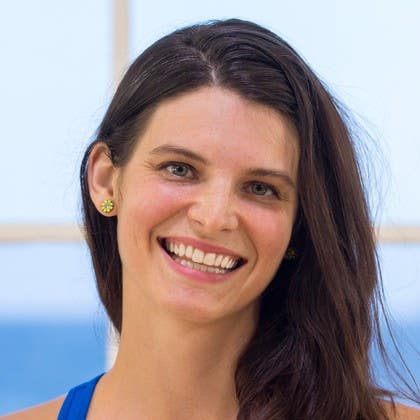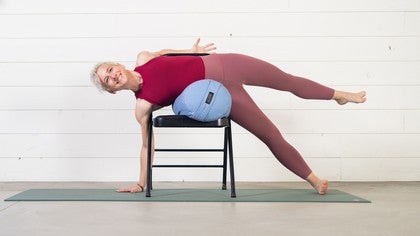
How Yoga and Strength Training Compliment Each Other
"I’m going to talk you through the entire thing," Robynn says calmly over Zoom. "You’ll start in a low plank and push through your heels, then lock out your knees and engage your quads. Squeeze your glutes...." Her list continues, but I’ve left my body, can only think about one thing at a time; it’s like I am looking down on myself from above. Glutes, I think. Ok. I squeeze, belly to spine. Shoulders are starting to burn. Breathe. "Now press the floor away from you with your palms and forearms," she continues, cool as a cucumber. "And then I’ll start the count." A bead of sweat rolls down my nose and splats onto my mat. "Ok..." I say. She starts our 30-second hold as my arms begin to shake visibly.
Strength training is new for me. I’ve been working with Robynn on and off for about a year, and before that, I only dabbled. Nothing formal, nothing serious. I considered myself pretty strong, and the five breaths I spent in Utkatasana seemed like enough for a while. But over time, my relationship with asana changed, primarily because of injury. I was running longer distances and needed real strength in my legs. My back injury bothered me when I laid down and made sleeping difficult. I was in so much pain a doctor told me I had to stop doing Ashtanga altogether. I googled "glute exercises for yoga" on the way home.
Addressing the pain in my butt
I’ve always loved doing different workouts and movement practices - everything from beginner ballet to a class called Brooklyn Booty - but yoga has always been the main event. However decades of repetitive movement and overstretching had given me a severe case of “yoga butt”: flat, weak, and the cause of, well, the pain in my butt. Yoga is a highly mobile system of movement, and for a hyper-mobile yogi like me, with connective tissue like melted butter, it was no longer enough to simply avoid my end range or keep a bend in my knees. I needed to actively work on building power in my muscles to keep my practice, and my body, healthy.Starting over
Strength training, or resistance training, uses bodyweight and tools, like stretch bands, kettlebells, or hand weights, to build muscle mass, endurance, and stability. Like yoga, it is a bit of an umbrella term and beneath it exists a universe of movement and modalities. The goal of strength training, at least for me, is right there in the name: Strength.
In the world of yoga, the goal is a little more nebulous, or at least more porous. Although I often reference intentions in class, over the last year or so it was unusual for me to know exactly what I intended when I set out on my yoga mat: Crow pose, core strength, mindfulness, enlightenment? I felt scattered mentally and just tried to stay focused on my breath. Just keep moving.
Strength training threw intentions into stark relief. And with it, all my deficits. In the beginning, it was frustrating. The cues and positions were just left of what I knew, and the repetitive sets annoyed me. Surely I don’t need to do another ten squats... I thought, separating my feet grudgingly. The alignment was different: my hands were too close, my shoulders too weak, my squat too stretchy, my pushups too chaturanga-y. And it was just hard. I was getting to know my body all over again, and it was weird. I thought of myself as strong, but after 1 set of Turkish Get-Ups, my shoulder muscles were fading, and my glutes had completely left the building. Even a basic push-up was difficult. Years of obsessing over chaturanga didn’t help - I learned to push forward from my feet in yoga, and in strength training, the heels should push back. It was like starting over, like there was so much I needed to undo. It was exhausting and dispiriting. Have I been moving wrong? Was yoga bad for me?
Building muscle (and a Beginner’s Mind)
"You’re thinking about this like a yogi", Robynn tells me. I’m in a low Plank again and rambling breathlessly about the position of my tailbone and how I feel too compact, too short. But the goal here is not to lengthen; it’s to strengthen. She laughs as she says that if we were in person, she would gently push me from all sides to test my stability. In yoga, we move from one pose to the next; we search for length, space, and stretch. In this version, there’s nowhere to go.
Even though I often feel like I’m leaving my body more than staying present, it’s a different kind of awareness from yoga. My muscles are less familiar with the movements and feel more acute. The goal is strength. The intention is "one more rep". I feel alive and powerful. And occasionally like absolute Jell-o. But like in yoga practice, there is always something interesting to observe about my body: the ways it responds and reacts. (And what it is capable of resisting!)
Beginner’s mind, called shoshin in Zen Buddhism, is the practice of dropping one’s expectations and preconceived notions and seeing with fresh eyes. I think of my niece learning to jump and run, filled with joy and excitement doing small clumsy laps around the house. No judgments, no expectations. When Robynn told me to stop thinking like a yogi, it was so obvious, like a light blinked on in my brain. Of course. This isn’t yoga. It wasn’t that I needed to undo anything, but rather, just do it differently.
Like anything, training can be yogic if I want it to be. But I like that it’s inherently not. I can take what I learn from strength training or beginner ballet, or whatever movement practice I’m participating in, and influence my yoga with it. But that’s all it is, just an influence.
A new relationship to movement
We often move from one pose to the next in yoga, particularly Ashtanga and Vinyasa styles. I’ve been doing that for years, using momentum. Now I’m learning how to be still - staying in one place. My body feels sturdy in planks now. When I move toward Upward Facing Dog, I do so with more power and intention.
I modify what I do in yoga now to make room for new learnings. My yoga practice hasn’t been this intentional in a long time, and it feels good. It feels fresh. Like I’m starting over. I do walkouts before Sun A, always. I add squats after Sun B, sometimes. I got rid of my yogi lens and looked at it from a beginner’s mind, and found yoga after all. And my butt has never felt better.
Comments

You need to be a subscriber to post a comment.
Please Log In or Create an Account to start your free trial.








